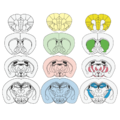Mouse brain
The article's lead section may need to be rewritten. (April 2019) |

The mouse brain refers to the
Mus musculus. Various brain atlases
exist.
For reasons of reproducibility, genetically characterized, stable strains like C57BL/6 were chosen to produce high-resolution images and databases.[1] Well known online resources include:
- Allen Brain Atlas[2]
- Mouse Brain Library[3]
- High resolution mouse brain atlas
- BrainMaps
Despite superficial differences, especially in size and weight, the mouse brain and its function can serve as a powerful
diseases or mental disorders (see e.g. Reeler, Chakragati mouse). This is because the genes responsible for building and operating both mouse and human brain are 90% identical.[4] Transgenic mouse lines also allow neuroscientists to specifically target the labeling of certain cell types to probe the neural basis of fundamental processes.[5][6]
Anatomy
The cerebral cortex of a mouse has around 8–14 million neurons while in those humans there are more than 10–15 billion.[7][8] The olfactory bulb volume takes about 2% of the mouse brain by volume in contrast to about 0.01% of the human brain.[9][10]
-
Mouse brain, dorsal view
-
Mouse brain, lateral view
-
Mousebrain slices
-
Mouse cingulate cortex neurons
-
A biophysically realistic model of the mouse primary motor cortex microcircuit representing a cylindrical volume of 300 μm diameter: 3D visualization, connectivity, dimensions, and neuronal densities, classes, and morphologies[11]
Development
See also
References
- S2CID 81057.
- ^ "ISH Data :: Allen Brain Atlas: Mouse Brain". ISH Data. Retrieved 2019-02-07.
- ^ "Search the library". The Mouse Brain Library. 2003-06-05. Retrieved 2019-02-07.
- ^ Park, Alice (19 January 2007). "The Brain: What the Mouse Brain Tells Us". Time.
- PMID 6261253.
- PMID 19283728.
- ^ "Brain size and intelligence- why a human is smarter than a mouse". DNALC Blogs «. 2012-11-13. Retrieved 2019-02-07.
- PMID 26418466.
- PMID 28495701.
- ^ "Brain Facts and Figures". faculty.washington.edu. Retrieved 2019-02-07.
- . Retrieved 21 June 2023.





![A biophysically realistic model of the mouse primary motor cortex microcircuit representing a cylindrical volume of 300 μm diameter: 3D visualization, connectivity, dimensions, and neuronal densities, classes, and morphologies[11]](http://upload.wikimedia.org/wikipedia/commons/thumb/5/56/M1_microcircuit_model.jpg/120px-M1_microcircuit_model.jpg)